Chicago Show: Cars, stars…and deep-dish pizza
Filed under: Equinox, Features, Autos
CHICAGO, IL.
There was a lot of talk about electric cars, hybrids, and autonomous (self-driving) vehicles, but the Chicago Auto Show best told the story of what car life in the U.S. is all about — trucks, SUVs…and more SUVs. One of the most impressive groups of new vehicles are the many midsize and compact crossovers.
After Toyota got things going with a display of high-performing off-road “TRD” models of its Tacoma and Tundra pickups, and its 4Runner SUV, Ford introduced the new generation of its Transit Connect, a compact, work-oriented mini-truck that fits and maneuvers in tight spaces and can be outfitted however a company or individual may choose.
To kick it off, Ford pulled a coup by having vice president Mark LaNeve call Jim Belushi to the stage, and Belushi walked out playing a harmonica and leading everyone in a spirited version of “Sweet Home, Chicago.” He intereviewed some in the audience, joked around with LaNeve, then enlisted him to join him in donning sunglasses to do a little Blues Brothers routine.
The versatility of the Transit Connect is that it could be everything from a foot truck, to a construction workers van, to a mini fun wagon, and while it doesn’t come in all-wheel drive, it does have a couple of new engines, including a 2.0-liter direct-injected 4 and a 1.5 -liter EcoBlue diesel engine with a new 8-speed automatic.
The Chicago Auto Show is the largest and longest-running auto show in the country, and in the opinion of everyone who attends, it also is by far the most fun of the major domestice shows. The lively nightlife scene and legendary restaurants help that reputation. The 110th Chicago Auto Show opened with media days in a nasty blizzard that lasted a day and a half and cancelled 600 flights into and out of O’Hare Airport — and it was still fun. It opened to the public on February 10 and anyone looking for a new car can spend hours examining everything offered in showrooms across the country on the 1,000-square-foot halls in McCormick Place, as it runs through Monday, Feb. 19.
Because it is definitely a consumer-driven show, Chicago provides an ample number of vehicles that appeal to mainstream, grassroots buyers. Its media survey to pick the Family Car of the Year came in with the Honda Odyssey, the latest generation of the popular and feature-filled minivan, which beat out other valid contenders including the Volvo XC-60 SUV, a midsize version of its SUV-of-the-Year XC-90.
There were not a lot of new introductions, after most of the debuts were spent on the Los Angeles show in November, and at Detroit in January. But there were definitely still some standouts, for the show, which got a rejuvenated restart in 1950 after the auto industry got rolling again following World War II.
With special attractions virtually every day, the Chicago show undoubtedly will be the best-attended show, again.
Consumers, of course, care less about the show-biz schemes than about sitting in and scrutinizing the cars. Read more
Cherokee altered for 2019 as mainstream winner
Filed under: Equinox, Autos
WESTLAKE VILLAGE, Ca.
When Jeep brought out its all-new Compass redesign a year ago, I thought Jeep might be wise to simply discontinue the Compass, because the stylishly larger Cherokee and the much larger Grand Cherokee covered the larger SUV end of the scale, the Wrangler had the rugged end blanketed, and the new, funky and popular Renegade was closing in from the smaller end.
Shows what I know. The Compass came out for 2018 with a neat, contemporary front end, bypassing the more unique looking Cherokee to become more similar to the larger Grand Cherokee, with its seven-slot grille. While shorter, the Compass also had more interior room than the Cherokee.
That sort of left the Cherokee hanging out to dry. When it was introduced in 2014, the Cherokee was striking in its departure from the signature look of its Jeep siblings, with a more horizontal grille topped by squinty-eyed headlights on the upper edge. My son, Jack, and I agreed it was the best-looking member of the Jeep family.
With every imaginable nook of the SUV and CUV scope seeming to be covered, the Compass was surprising both because it is impressive even if it comes only with a 2.4-liter 4-cylinder engine, and for some reason, Jeep designers allowed it to have more interior room than the larger Cherokee. That’s like giving the little brother weight-training until he’s more capable than big brother.
Ah, but now we learn of Jeep’s long-range plan. With the Compass all new a a 2018 model, the next Cherokee has just been introduced as a 2019 vehicle, and invited auto media got a chance to drive it hard, on highways, bad roads, and off-road terrain a sane person might never consider driving a vehicle. In a word, the bigger and roomier Cherokee regains its rightful slot as being just under the Grand Cherokee, and more capable than the Renegade, Wrangler or Compass, if you count everyday highway driving and family duties as a prime consideration.
The new Cherokee uses the 2.4, which is the only engine in the Compass, but it also gets the impressive 3.2-liter V6 for optimum towing capability. The prize of the litter, in my opinion, is the new-design 2.0-liter 4-cylinder, which is an amazingly potent little powerplant that already is enjoying a strong start to its heritage. It is the same engine used by the all-new Wrangler, which is still the company’s over-achieving all-terrain champ. But in the Cherokee, the 2.0 pushes it to the front of the class, even against the Grand Cherokee for real-world use.
And all the Cherokee had to sacrifice to carve its new niche was its look of uniqueness. I’m sorry to see the squinty-eyed lights go away, and I’m a little disappointed to see Cherokee’s styling leave being unique behind for a return to the family focus of vertical seven-slot grille with nests of LED lights enclosed in a single pod on either side of the new grille.
But I will give it this: No matter how much you like the current Cherokee styling, once you’re inside, driving or riding, you don’t even think of how the exterior of your vehicle looks. The inside of the Cherokee has grown up a bit, to reclaim the volume that puts it in its rightful place above the upstart Compass — even though I now think the Cherokee and Compass look remarkably similar. To be annoying, I asked various Jeep executives which they’re rather have now as a family utility, and most of them had trouble choosing. Read more
Challenger GT goes, where others spin their tires
Filed under: Weekly test drives, Autos
By John Gilbert
What’s wrong with this picture, as they say? It’s a photo of a beautiful new Dodge Challenger parked along a North Shore cove in Two Harbors, Minnesota, overlooking an icy Lake Superior, and sitting on a snowy, icy parking area.
Everyone know that the resurrection of the “Big Three” ponycars — the Ford Mustang, Chevrolet Camaro, and Dodge Challenger — is heartwarming and attractive, but those wonderful hot cars from the late 1960s through 1970 had one thing in common: front engine and rear drive. You either chose judiciously when to venture out between November and April, or, better, you parked them during the winter months.
With their wide tires and ready-to-race demeanor, those cars traditionally are not what yoiu think you should be driving in slippery conditions.
However, we now must make an exception. While the Mustang and Camaro have been modernized in styling updates in recent years, the Challenger has stayed truest to its 1970-era roots. Until now. Dodge made the most publicity out of adding the SRT Hellcat powertrain, and the over-the-top 808 horsepower Demon model.
Flying well below that outrageous 2018 power display, Challenger has added a GT model, which comes with a strong 3.6-liter V6 engine and winter-beating all-wheel drive. Think about that: all-wheel drive! The GT term, which traditionally stands for Grand Touring (or Gran Turismo).sounds like it should be hotter than its siblings, even the Hellcat and other huge-engined monsters, but in reality is possibly the best real-world model of all the ponycars.
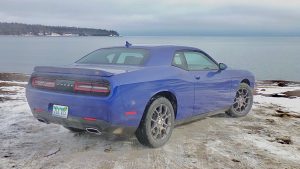
Challenger GT styling can be called “future-retro,” but for 2018, it houses a lot of technical advances.
The Challenger GT I recently test-drove was painted a stunning “IndiGo” blue, and otherwise, except for black alloy wheels and a tastefully small “GT” on its flanks, doesn’t jump out as a high performer. But take it up an icy avenue in Duluth, or drive off the street into the ice-covered parking area near Two Harbors, and when you want to go, just shift the 8-speed TorqueFlite transmission into “D” and step on the gas.
The familiar 3.6-liter V6 is perfectly tuned to operate the car, and it sends its 305 horsepower and 262 foot-pounds of torque down through its four specially-selected Michelin Primacy MXM4 tires, which we probably can call “high-performance/all-season” tires.
At its introduction, I was able to drive a Challenger GT on an icy test facility in Maine late last winter, and I got a real eye-opening experience at the FCA proving grounds at Auburn Hills, Michigan, where I drove an assortment of high-powered Challengers with their Hemi V8s up to over 800 supercharged horsepower. To my amazement, I found that on a specific part of that track, there is a serpentine stretch where the track gives you about a hundred-yard straight stretch, then a 180-degree switchback, back and forth for about six such turns.
I came away convinced that the precise steering and handling of the Challenger GT made the V6 model with AWD possibly the best-handling Challenger of all — and, in fact, maybe the best-handling car of any name ever made by Dodge. Read more


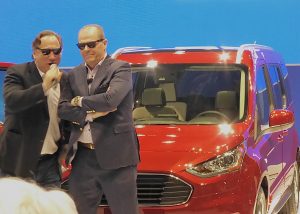
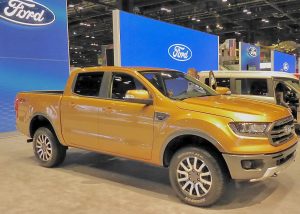

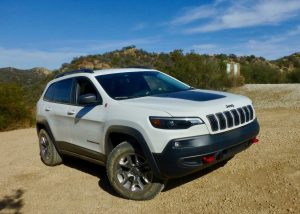
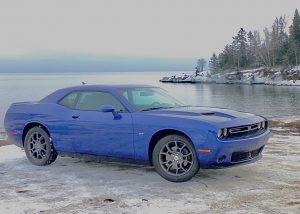
 John Gilbert is a lifetime Minnesotan and career journalist, specializing in cars and sports during and since spending 30 years at the Minneapolis Tribune, now the Star Tribune. More recently, he has continued translating the high-tech world of autos and sharing his passionate insights as a freelance writer/photographer/broadcaster. A member of the prestigious North American Car and Truck of the Year jury since 1993. John can be heard Monday-Friday from 9-11am on 610 KDAL(www.kdal610.com) on the "John Gilbert Show," and writes a column in the Duluth Reader.
John Gilbert is a lifetime Minnesotan and career journalist, specializing in cars and sports during and since spending 30 years at the Minneapolis Tribune, now the Star Tribune. More recently, he has continued translating the high-tech world of autos and sharing his passionate insights as a freelance writer/photographer/broadcaster. A member of the prestigious North American Car and Truck of the Year jury since 1993. John can be heard Monday-Friday from 9-11am on 610 KDAL(www.kdal610.com) on the "John Gilbert Show," and writes a column in the Duluth Reader.